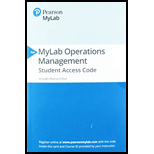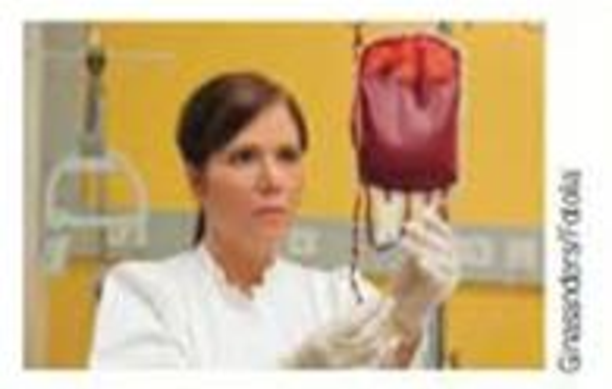
Concept explainers
Ethical Dilemma
Wayne Hills Hospital in tiny Wayne, Nebraska, faces a problem common to large, urban hospitals as well as to small, remote ones like itself. That problem is deciding how much of each type of whole blood to keep in stock. Because blood is expensive and has a limited shelf life (up to 5 weeks under 1–6°C refrigeration). Wayne Hills naturally wants to keep its stock as low as possible. Unfortunately, past disasters such as a major tornado and a train wreck demonstrated that lives would be lost when not enough blood was available to handle massive needs. The hospital administrator wants to set an 85% service level based on demand over the past decade. Discuss the implications of this decision. What is the hospital’s responsibility with regard to stocking lifesaving medicines with short shelf lives? How would you set the inventory level for a commodity such as blood?

Introduction: WH hospital at city N faces issues from its largest hospital in urbans to its smallest hospitals in rural ones like itself. The problems is that how much of blood to keep in stock. Blood is expensive and it has only limited shelf life and so the WH wants to keep its inventory as low as possible but the recent disaster cost many lives where there came a massive need for blood.
The administrator want to set 85% service level based on the demand in over past few decades.
To determine: The implications of the hospital’s decision and the hospital’s responsibility in stocking the blood with short shelf lives and setting of inventory level for commodity like blood.
Explanation of Solution
Implications of the hospital’s decision and the hospital’s responsibility in stocking the blood with short shelf lives and setting of inventory level for commodity like blood:
The hosptial’s decision of maintaining 85% service level to meet inventory demand is the decision made by the manger which cannot be questioned since keeping higher stock without use would lead to more wastages. Though maintaining less inventory is favorable and cost saving, the hospital management must be ready to meet sudden rise in demand and any big disasters.
The hospitals can tie up with another hospitals or blood bank to meet higher demand. This way will serve both purpose of meeting the demand and as well as cost savings but putting price tag on blood is highly questionable. Setting inventory for short shelf life product is left to the management who must decide the inventory level but since blood is a life saving commodity, the management must be prepared at any time to meet higher requirement without the costing any lifes.
Want to see more full solutions like this?
Chapter 12 Solutions
EBK PRINCIPLES OF OPERATIONS MANAGEMENT
- Identify specific performance management processes covered in this course and how each aligns with an elements of LaFevor’s HCMS Model.arrow_forwardIdentify specific performance management processes covered in this course and how each aligns with LaFevor’s HCMS Model. LaFevor, K. (2017). What’s in Your Human Capital Management Strategy? The Game Plan, the Path, and Achievingarrow_forwardassess how Human Capital Management Strategy is aimed at building an effective integrated performance management system: Discuss how human capital management strategy relates to performance management.arrow_forward
- CASE STUDY 9-1 Was Robert Eaton a Good Performance Management Leader? R obert Eaton was CEO and chairman of Chrys- ler from 1993 to 1998, replacing Lee Iacocca, who retired after serving in this capacity since 1978. Eaton then served as cochairman of the newly merged DaimlerChrysler organization from 1998 to 2000. In fact, Eaton was responsible for the sale of Chrysler Corporation to Daimler-Benz, thereby creating DaimlerChrysler. With 362,100 employees, DaimlerChrysler had achieved revenues of €136.4 billion in 2003. DaimlerChrysler's passenger car brands included Maybach, Mercedes-Benz, Chrysler, Jeep, Dodge, and Smart. Commercial vehicle brands included Mercedes-Benz, Freightliner, Sterling, Western Star, and Setra. From the beginning of his tenure as CEO, Eaton communicated with the people under him. He immediately shared his plans for the future with his top four executives, and upon the advice of his colleague, Bob Lutz, decided to look around the company before making any hasty…arrow_forwardCritically assess Martin’s coaching style.arrow_forwardCompare Robert Eaton’s performance management leadership presented in the case against the performance management leadership principles, functions, and behaviors. What recommendations can be made about what he might do more effectively? Explain and defend your answer.arrow_forward
- In the context of the material in Chapter 9, provide a critical analysis of the decisions that Henry has made in assigning Martin to this role.arrow_forwardpanies (pp. 80-118). New York, NY: Times Books, specifically Chap. 4, "Robert Eaton and Robert Lutz; The Copilots." CASE STUDY 9-2 Performance Management Leadership at Henry's Commercial Sales and Leasing H enry is the owner of a small real estate agency that handles the sale and leasing of commercial property. He has two real estate agents working in the office, along with himself. He also has two customer service representatives (CSRs), each of whom has a real estate license, and one receptionist who has worked for the company for about three months. Henry has recently decided that he needs another customer service representative. He hasarrow_forwardDiscuss possible solutions to help Tara become an effective CSR. What should martin be doing to help her?arrow_forward
- What are the ethical challenges regarding employees (i.e., diversity, discrimination, sexual harassment, privacy, employee theft, bad leadership, etc.) that Apple Inc. has faced over the past five to ten years and that they should prepare to face in the next five to ten years. Once a developed list of challenges is created, consider how having faced those challenges will impact and be impacted by the social cause you've selected. Propose the findings on the ethical challenges faced by Apple Inc. in recent history and the near future. Analyze ways in which each challenge was (and/or could be) appropriately handled and areas for improvement. Evaluate the ethical/moral aspects of Apple Inc. that protected it from ethical challenges in the past and could protect it in the future. Assess how ethical challenges and handling of ethical challenges could positively or negatively impact the charitable cause are selected and how the selection of your social cause could positively or negatively…arrow_forwardBy selecting Cigna Accredo pharmacy that i identify in my resand compare the current feedback system against the “Characteristics of a Good Multiple Source Feedback Systems” described in section 8-3-3. What can be improved? As a consultant, what recommendations would you make?arrow_forwardScenario You have been given a task to create a demand forecast for the second year of sales of a premium outdoor grill. Accurate forecasts are important for many reasons, including for the company to ensure they have the materials they need to create the products required in a certain period of time. Your objective is to minimize the forecast error, which will be measured using the Mean Absolute Percentage Error (MAPE) with a goal of being below 25%. You have historical monthly sales data for the past year and access to software that provides forecasts based on five different forecasting techniques (Naïve, 3-Month Moving Average, Exponential Smoothing for .2, Exponential Smooth for .5, and Seasonal) to help determine the best forecast for that particular month. Based on the given data, you will identify trends and patterns to create a more accurate forecast. Approach Consider the previous month's forecast to identify which technique is most effective. Use that to forecast the next…arrow_forward
 Purchasing and Supply Chain ManagementOperations ManagementISBN:9781285869681Author:Robert M. Monczka, Robert B. Handfield, Larry C. Giunipero, James L. PattersonPublisher:Cengage Learning
Purchasing and Supply Chain ManagementOperations ManagementISBN:9781285869681Author:Robert M. Monczka, Robert B. Handfield, Larry C. Giunipero, James L. PattersonPublisher:Cengage Learning Practical Management ScienceOperations ManagementISBN:9781337406659Author:WINSTON, Wayne L.Publisher:Cengage,
Practical Management ScienceOperations ManagementISBN:9781337406659Author:WINSTON, Wayne L.Publisher:Cengage,


